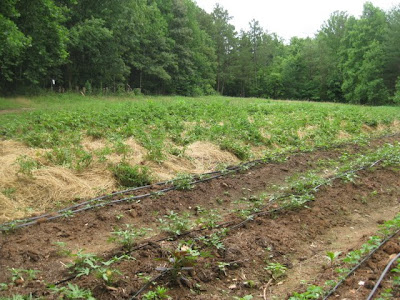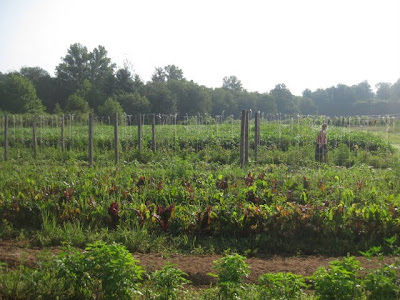July 13th Humidity!
The other night we could have cut the air with a knife, or perhaps stabbed it with our digging forks. We had waited until the sun was safely sinking behind trees to go dig potatoes. But the heat lingered in the sweat soaked air. Trees only 100 feet away were blurry around the edges from the water in the air. It was like digging potatoes while swimming, only not as refreshing. Fortunately, the recent rains had softened the soil so it was relatively easy to dig. Just last week, before the rains, I had dug a few test plants. I had to jump on the fork just to force it into the soil. Now I could easily stab it into the earth with only my arms.
A healthy soil is only about 50% solid material. The rest is airspace that fluctuates between air and water. When the soil is very dry the soil particles are locked together, they do not want to yield to a fork or shovel. Water filling some of those gaps makes the soil more malleable. It will move over so to speak for the tool as it digs in. We certainly appreciated the extra help!

Potatoes before harvest
July 20th Season of Harvest
Lately it feels like all we’ve been doing is harvesting. All year leading up to this point we’ve prepared beds, weeded, started transplants, set transplants out, weeded some more, watered, trellised, and many other vegetable projects I can’t even remember. Of course we were harvesting, but now we are really harvesting. All the summer crops need to be harvested every other day at least because the fruit just keep on coming. They’re not like greens or root crops that can wait until a planed harvest day. Instead, it’s just harvest, harvest, harvest. It is wonderful to be able to see the fruits of all our hard spring labor coming to harvest.

Cherry tomatoes with their friends the marigolds

Marie in the cucumber patch
August 2nd Farm News
This week we have finally been catching up to ourselves and cleaning up some of the spring crops. The least fun part of that job is cleaning up the old irrigation line. It is a thin plastic tube that we laid out on the nicely tilled ground back in March. Since then dirt has been thrown over the tubing and the weeds have gone crazy. Now we get to not only find the irrigation line in all that mess, but pull it out, without losing the many 6 inch long sod staples we used to hold it in place before the weeds took over. Then we get to do it 36 more times-once for each line! With that out of the way the job gets considerably easier. I hop on the tractor and prepare the ground for a cover crop, plant the seed, and use the tractor to till the seed in.
Before the tractor work could begin though we also had to play a fun game we called “find the black widow spider!” In the spring (and fall) we use a thin cloth covering to help protect our plants from the frost. We hold the row cover down with sandbags. This spring, when we were done using them we just piled them at the heads of the bed. Today we had to move them out of the way of the tractor paths. It turns out that the moist, cool, full of good hiding spaces habitat formed by a pile of sandbags is ideal for black widow spiders. We found 10, most with egg sacks, in only 3 piles! We had previously noticed that we were finding more than usual around our house and farm already. It must be a good year for them. So if you are going our back to move and old lumber pile or clean up the junk heap, be careful!
In addition to planting one cover crop we are busy incorporating another. A cover crop of millet and cowpeas we planted in the spring had reached head high-ready to mow. Some of the crop I had to mow because we needed to chop in down quickly for the imminent planting of fall crops. However, in another section, we are letting the sheep do the mowing. When we first put them into the paddock they were a little nervous because the crop was taller than the grass they were used to. Consequently, they couldn’t see very far. They kept poking their heads up as high as they could reach to try to get a better view. Every time another sheep or Clyde the guard dog would unexpectedly burst through the tall plants they would spook and jump away. Interestingly, they all turned their noses up at the crop for the first few hours. They wanted their regular grass and were having no part of the millet and cowpea mix. The sheep just weren’t sure they believed us when we told them that a book had told us that they would like the cover crop. Fortunately, instead of breaking out of the fence they eventually sampled the available food and decided it was acceptable.
